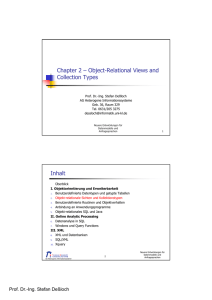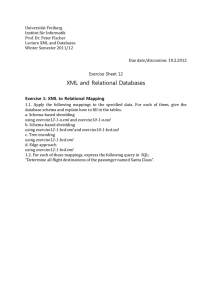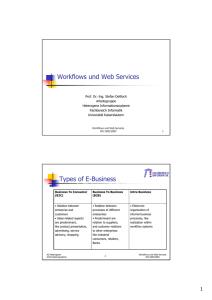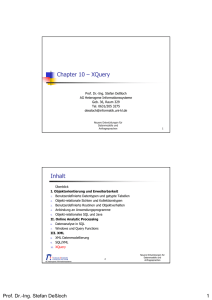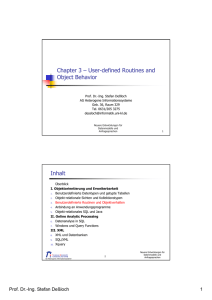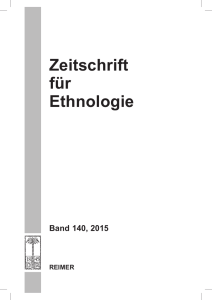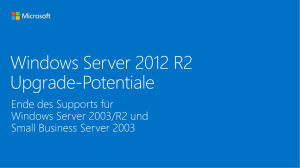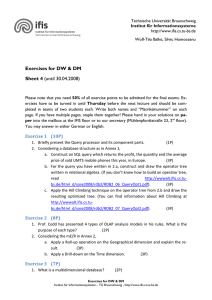Chapter 8 – XML Data Modeling Inhalt
Werbung
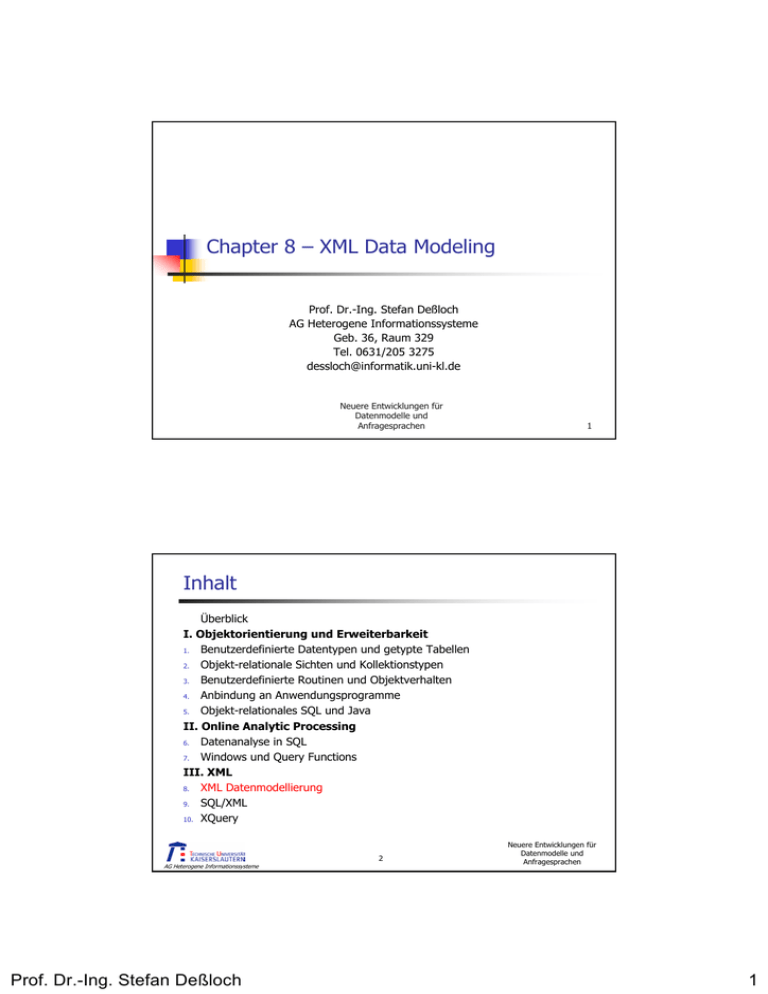
Chapter 8 – XML Data Modeling Prof. Dr.-Ing. Stefan Deßloch AG Heterogene Informationssysteme Geb. 36, Raum 329 Tel. 0631/205 3275 [email protected] Neuere Entwicklungen für Datenmodelle und Anfragesprachen 1 Inhalt Überblick I. Objektorientierung und Erweiterbarkeit 1. Benutzerdefinierte Datentypen und getypte Tabellen 2. Objekt-relationale Sichten und Kollektionstypen 3. Benutzerdefinierte Routinen und Objektverhalten 4. Anbindung an Anwendungsprogramme 5. Objekt-relationales SQL und Java II. Online Analytic Processing 6. Datenanalyse in SQL 7. Windows und Query Functions III. XML 8. XML Datenmodellierung 9. SQL/XML 10. XQuery 2 AG Heterogene Informationssysteme Prof. Dr.-Ing. Stefan Deßloch Neuere Entwicklungen für Datenmodelle und Anfragesprachen 1 XML Origin and Usages Defined by the WWW Consortium (W3C) Originally intended as a document markup language, not a database language Documents have tags giving extra information about sections of the document For example: Derived from SGML (Standard Generalized Markup Language) standard for document description main idea: separate form from structure <title> XML </title> <slide> XML Origin and Usages </slide> enables document interchange in publishing, office, engineering, … XML is simpler to use than SGML roughly 20% complexity achieves 80% functionality 3 AG Heterogene Informationssysteme Neuere Entwicklungen für Datenmodelle und Anfragesprachen XML Origin and Usages (cont.) XML documents are to some extent self-documenting Tags can be used as metadata Example <bank> <account> <account-number> A-101 </account-number> <branch-name> Downtown </branch-name> <balance> 500 </balance> </account> <depositor> <account-number> A-101 </account-number> <customer-name> Johnson </customer-name> </depositor> </bank> 4 AG Heterogene Informationssysteme Prof. Dr.-Ing. Stefan Deßloch Neuere Entwicklungen für Datenmodelle und Anfragesprachen 2 Forces Driving XML Document Processing Data Bases and Data Exchange Goal: use document in various, evolving systems structure – content – layout grammer: markup vocabulary for mixed content Goal: data independence structured, typed data – schema-driven – integrity constraints Semi-structured Data and Information Integration Goal: integrate autonomous data sources data source schema not known in detail – schemata are dynamic schema might be revealed through analysis only after data processing Neuere Entwicklungen für Datenmodelle und Anfragesprachen 5 AG Heterogene Informationssysteme XML Language Specifications XSL XML Link XML Pointer XPath XQuery XSLT XML Schema XSL-FO XML Namespace XML Metadata Interchange XHML eXtensible Markup Language Cascading Style Sheets Unified Modeling Language Standardized Generalized Markup Language Meta Object Facility Unicode Document Type Definition 6 AG Heterogene Informationssysteme Prof. Dr.-Ing. Stefan Deßloch Neuere Entwicklungen für Datenmodelle und Anfragesprachen 3 Describing XML Data: Basics - Elements Tag: label for a section of data Element: section of data beginning with <tagname> and ending with matching </tagname> Elements must be properly nested Formally: every start tag must have a unique matching end tag, that is in the context of the same parent element. Every document must have a single top-level element Mixture of text with sub-elements is legal in XML Example: <account> This account is seldom used any more. <account-number> A-102</account-number> <branch-name> Perryridge</branch-name> <balance>400 </balance> </account> Useful for document markup, but discouraged for data representation 7 AG Heterogene Informationssysteme Neuere Entwicklungen für Datenmodelle und Anfragesprachen XML Document Example <bank-1> <customer> <customer-name> Hayes </customer-name> <customer-street> Main </customer-street> <customer-city> Harrison </customer-city> <account> <account-number> A-102 </account-number> <branch-name> Perryridge </branch-name> <balance> 400 </balance> </account> <account> … </account> </customer> . . </bank-1> 8 AG Heterogene Informationssysteme Prof. Dr.-Ing. Stefan Deßloch Neuere Entwicklungen für Datenmodelle und Anfragesprachen 4 Describing XML Data: Attributes Attributes: can be used to describe elements Elements can have attributes <account acct-type = “checking” > <account-number> A-102 </account-number> <branch-name> Perryridge </branch-name> <balance> 400 </balance> </account> Attributes are specified by name=value pairs inside the starting tag of an element Attribute names must be unique within the element <account acct-type = “checking” monthly-fee=“5”> 9 AG Heterogene Informationssysteme Neuere Entwicklungen für Datenmodelle und Anfragesprachen Attributes vs. Subelements Distinction between subelement and attribute In the context of documents, attributes are part of markup, while subelement contents are part of the basic document contents In the context of data representation, the difference is unclear and may be confusing Same information can be represented in two ways <account account-number = “A-101”> …. </account> <account> <account-number>A-101</account-number> … </account> 10 AG Heterogene Informationssysteme Prof. Dr.-Ing. Stefan Deßloch Neuere Entwicklungen für Datenmodelle und Anfragesprachen 5 More on XML Syntax Shortcut: elements without subelements or text content can be abbreviated by ending the start tag with a /> and deleting the end tag <account number=“A-101” branch=“Perryridge” balance=“200” /> To store string data that may contain tags, without the tags being interpreted as subelements, use CDATA as below <![CDATA[<account> … </account>]]> Here, <account> and </account> are treated as just strings 11 AG Heterogene Informationssysteme Neuere Entwicklungen für Datenmodelle und Anfragesprachen XML Document Schema Metadata and database schemas constrain what information can be stored, and the data types of stored values Metadata are very important for data exchange Guarantees automatic and correct data interpretation XML documents are not required to have associated metadata/schema Two mechanisms for specifying XML schema Document Type Definition (DTD) XML Schema 12 AG Heterogene Informationssysteme Prof. Dr.-Ing. Stefan Deßloch Neuere Entwicklungen für Datenmodelle und Anfragesprachen 6 Describing XML Data: DTD Type and structure of an XML document can be specified using a DTD What elements can occur What attributes can/must an element have What subelements can/must occur inside each element, and how many times. DTD does not constrain data types DTD syntax All values represented as strings in XML <!ELEMENT element (subelements-specification) > <!ATTLIST element (attributes) > 13 AG Heterogene Informationssysteme Neuere Entwicklungen für Datenmodelle und Anfragesprachen Element Specification in DTD Subelements can be specified as names of elements, or #PCDATA (parsed character data), i.e., character strings EMPTY (no subelements) or ANY (anything can be a subelement) Example <! ELEMENT depositor (customer-name account-number)> <! ELEMENT customer-name(#PCDATA)> <! ELEMENT account-number (#PCDATA)> Subelement specification may have regular expressions <!ELEMENT bank ( ( account | customer | depositor)+)> Notation: “|” “?” “+” “*” - alternatives 0 or 1 occurrence 1 or more occurrences 0 or more occurrences 14 AG Heterogene Informationssysteme Prof. Dr.-Ing. Stefan Deßloch Neuere Entwicklungen für Datenmodelle und Anfragesprachen 7 Example: Bank DTD <!DOCTYPE bank [ <! ELEMENT bank ( ( account | customer | depositor)+)> <! ELEMENT account (account-number branch-name balance)> <! ELEMENT customer(customer-name customer-street customer-city)> <! ELEMENT depositor (customer-name account-number)> <! ELEMENT account-number (#PCDATA)> <! ELEMENT branch-name (#PCDATA)> <! ELEMENT balance(#PCDATA)> <! ELEMENT customer-name(#PCDATA)> <! ELEMENT customer-street(#PCDATA)> <! ELEMENT customer-city(#PCDATA)> ]> 15 AG Heterogene Informationssysteme Neuere Entwicklungen für Datenmodelle und Anfragesprachen Attribute Specification in DTD Attribute specification : for each attribute Name Type of attribute Whether CDATA ID (identifier) or IDREF (ID reference) or IDREFS (multiple IDREFs) mandatory (#REQUIRED) default value (value), or neither (#IMPLIED) Examples <!ATTLIST account acct-type CDATA “checking”> <!ATTLIST customer customer-id ID #REQUIRED accounts IDREFS #REQUIRED > 16 AG Heterogene Informationssysteme Prof. Dr.-Ing. Stefan Deßloch Neuere Entwicklungen für Datenmodelle und Anfragesprachen 8 IDs and IDREFs An element can have at most one attribute of type ID The ID attribute value of each element in an XML document must be distinct Î ID attribute (value) is an object identifier An attribute of type IDREF must contain the ID value of an element in the same document An attribute of type IDREFS contains a set of (0 or more) ID values. Each ID value must contain the ID value of an element in the same document IDs and IDREFs are untyped, unfortunately Example below: The owners attribute of an account may contain a reference to another account, which is meaningless; owners attribute should ideally be constrained to refer to customer elements Neuere Entwicklungen für Datenmodelle und Anfragesprachen 17 AG Heterogene Informationssysteme Example: Extended Bank DTD Bank DTD with ID and IDREF attribute types <!DOCTYPE bank-2[ <!ELEMENT account (branch-name, balance)> <!ATTLIST account account-number ID #REQUIRED owners IDREFS #REQUIRED> <!ELEMENT customer(customer-name, customer-street, customer-city)> <!ATTLIST customer customer-id accounts ]> ID IDREFS #REQUIRED #REQUIRED> … declarations for branch, balance, customer-name, customer-street and customer-city 18 AG Heterogene Informationssysteme Prof. Dr.-Ing. Stefan Deßloch Neuere Entwicklungen für Datenmodelle und Anfragesprachen 9 XML data with ID and IDREF attributes <bank-2> <account account-number=“A-401” owners=“C100 C102”> <branch-name> Downtown </branch-name> <balance>500 </balance> </account> ... <customer customer-id=“C100” accounts=“A-401”> <customer-name>Joe</customer-name> <customer-street>Monroe</customer-street> <customer-city>Madison</customer-city> </customer> <customer customer-id=“C102” accounts=“A-401 A-402”> <customer-name> Mary</customer-name> <customer-street> Erin</customer-street> <customer-city> Newark </customer-city> </customer> </bank-2> 19 AG Heterogene Informationssysteme Neuere Entwicklungen für Datenmodelle und Anfragesprachen Describing XML Data: XML Schema XML Schema is closer to the general understanding of a (database) schema XML Schema supports Typing of values E.g. integer, string, etc Constraints on min/max values Typed references User defined types Specified in XML syntax (unlike DTDs) Integrated with namespaces Many more features List types, uniqueness and foreign key constraints, inheritance .. BUT: significantly more complicated than DTDs 20 AG Heterogene Informationssysteme Prof. Dr.-Ing. Stefan Deßloch Neuere Entwicklungen für Datenmodelle und Anfragesprachen 10 XML Schema Structures Datatypes (Part 2) Describes Types of scalar (leaf) values Structures (Part 1) Describes types of complex values (attributes, elements) Regular tree grammars repetition, optionality, choice recursion Integrity constraints Functional (keys) & inclusion dependencies (foreign keys) Subtyping (akin to OO models) Describes inheritance relationships between types Supports schema reuse 21 AG Heterogene Informationssysteme Neuere Entwicklungen für Datenmodelle und Anfragesprachen XML Schema Structures (cont.) Elements : tag name & simple or complex type <xs:element name=“sponsor” type=“xsd:string”/> <xs:element name=“action” type=“Action”/> Attributes : tag name & simple type <xs:attribute name=“date” type=“xsd:date”/> Complex types <xs:complexType name=“Action”> <xs:sequence> <xs:elemref name =“action-date”/> <xs:elemref name =“action-desc”/> </xs:sequence> </xs:complexType> 22 AG Heterogene Informationssysteme Prof. Dr.-Ing. Stefan Deßloch Neuere Entwicklungen für Datenmodelle und Anfragesprachen 11 XML Schema Structures (cont.) Sequence <xs:sequence> <xs:element name=“congress” type=xsd:string”/> <xs:element name=“session” type=xsd:string”/> </xs:sequence> Choice <xs:choice> <xs:element name=“author” type=“PersonName”/> <xs:element name=“editor” type=“PersonName”/> </xs:choice> Repetition <xs:sequence minOccurs=“1” maxOccurs=“unbounded”> <xs element name =“section” type=“Section”/> </xs:sequence> 23 AG Heterogene Informationssysteme Neuere Entwicklungen für Datenmodelle und Anfragesprachen Namespaces A single XML document may contain elements and attributes defined for and used by multiple software modules Motivated by modularization considerations, for example Name collisions have to be avoided Example: A Book XSD contains a Title element for the title of a book A Person XSD contains a Title element for an honorary title of a person A BookOrder XSD reference both XSDs Namespaces specifies how to construct universally unique names 24 AG Heterogene Informationssysteme Prof. Dr.-Ing. Stefan Deßloch Neuere Entwicklungen für Datenmodelle und Anfragesprachen 12 Namespaces (cont.) Namespace is a collection of names identified by a URI Namespaces are declared via a set of special attributes These attributes are prefixed by xmlns - Example: <BookOrder xmlns:Customer="http://mySite.com/Person" xmlns:Item="http://yourSite.com/Book"> Namespace applies to the element where it is declared, and all elements within its content unless overridden Elements/attributes from a particular namespace are prefixed by the name assigned to the namespace in the corresponding declaration of the using XML document ...Customer:Title='Dr'... ...Item:Title='Introduction to XML'... Default namespace declaration for fixing the namespace of unqualified names Example: <BookOrder xmlns="http://mySite.com/Person" xmlns:Item="http://yourSite.com/Book"> 25 AG Heterogene Informationssysteme Neuere Entwicklungen für Datenmodelle und Anfragesprachen Namespaces and XML Schema XML-Schema elements and data types are imported from the XML-Schema namespace http://www/w3/org/2001/XMLSchema xsd is generally used as a prefix The vocabulary defined in an XML Schema file belongs to a target namespace declared using the targetNamespace attribute declaring a target namespace is optional if none is provided, the vocabulary does not belong to a namespace required for creating XML schemas for validating (pre-namespace) XML1.0 documents XML document using an XML schema declares namespace, refers to the target namespace of the underlying schema can provide additional hints where an XML schema (xsd) file for the namespace is located schemaLocation attribute 26 AG Heterogene Informationssysteme Prof. Dr.-Ing. Stefan Deßloch Neuere Entwicklungen für Datenmodelle und Anfragesprachen 13 XML Schema Version of Bank DTD <xsd:schema xmlns:xsd="http://www.w3.org/2001/XMLSchema" targetNamespace="http://www.banks.org" xmlns ="http://www.banks.org" > <xsd:element name=“bank” type=“BankType”/> <xsd:element name=“account”> <xsd:complexType> <xsd:sequence> <xsd:element name=“account-number” type=“xsd:string”/> <xsd:element name=“branch-name” type=“xsd:string”/> <xsd:element name=“balance” type=“xsd:decimal”/> </xsd:sequence> </xsd:complexType> </xsd:element> ….. definitions of customer and depositor …. <xsd:complexType name=“BankType”> <xsd:choice minOccurs="1" maxOccurs="unbounded"> <xsd:element ref=“account”/> <xsd:element ref=“customer”/> <xsd:element ref=“depositor”/> </xsd:choice> </xsd:complexType> </xsd:schema> 27 AG Heterogene Informationssysteme Neuere Entwicklungen für Datenmodelle und Anfragesprachen XML Document Using Bank Schema <bank xmlns="http://www.banks.org" xmlns:xsi="http://www.w3.org/2001/XMLSchema-instance" xsi:schemaLocation="http://www.banks.org Bank.xsd"> <account> <account-number> … </account-number> <branch-name> … </branch-name> <balance> … </balance> </account> … </bank> 28 AG Heterogene Informationssysteme Prof. Dr.-Ing. Stefan Deßloch Neuere Entwicklungen für Datenmodelle und Anfragesprachen 14 Assertions in XML-Schema Uniqueness: UNIQUE-Element, KEY-Element forces uniqueness of attribute or element values can be applied to/declared for specific parts of the XML document <field> elemen(s) <selector> element Example: zip-codes should be unique for a combination of region and part number <unique name=”constraint1”> <selector xpath=”//regions/zip” /> <field xpath=”@code” /> <field xpath=”part/@number” /> </unique> Some remarks NULL value semantics: nillable at the schema level, nil in the document <key> equivalent to <unique> and nillable="false" uniqueness can be reduced to XML fragments composite keys/unique elements Neuere Entwicklungen für Datenmodelle und Anfragesprachen 29 AG Heterogene Informationssysteme Mapping ER-Model -> XML Schema Mapping Entities 1:1 mapping to XML elements use <key> to represent ER key attributes street anr ... name ABT <element name=”ABT”> <complexType> <attribute name=”anr” type=”string” /> <attribute name=”street” type=”string” /> <attribute name=”name” type=”string” /> </complexType> </element> ... <key name=”abt_pk”> <selector xpath=”.//ABT/” /> <field xpath=”@anr” /> </key> ... 30 AG Heterogene Informationssysteme Prof. Dr.-Ing. Stefan Deßloch Neuere Entwicklungen für Datenmodelle und Anfragesprachen 15 Mapping 1:N Relationships Mapping alternatives street <element name="ABT"> <complexType> <sequence> <element name="ANG"> <complexType> <attribute name="name" type="string"/> <attribute name="office" type="string"/> </complexType> </element> </sequence> <attribute name="street" type="string"/> <attribute name="name" type="string"/> </complexType> </element> anr ABT 1 ABT-ANG N ANG name name Nesting Flat representation pnr office ... <element name=”ANG”> <complexType> <attribute name=”name” type=”string” /> <attribute name=”office” type=”string” /> </complexType> </element> <element name=”ABT”> <complexType> <sequence> <element ref=”ANG”> </sequence> <attribute name=”street” type=”string” /> <attribute name=”name” type=”string” /> </complexType> </element> 31 AG Heterogene Informationssysteme Neuere Entwicklungen für Datenmodelle und Anfragesprachen Primary/Foreign Keys Problem nesting alone is not sufficient for modeling a 1:n relationship element identity is required to avoid duplicate entries Foreign Keys guarantee referential integrity: <key> / <keyref> elements <element name="ABT"> <complexType> <sequence> <element name="ANG"> <complexType> <attribute name="pnr" type="string"/> <attribute name="name" type="string"/> <attribute name="office" type="string"/> <attribute name="abtid" type="string"/> </complexType> </element> </sequence> <attribute name="anr" type="string"/> <attribute name="name" type="string"/> <attribute name="street" type="string"/> </complexType> </element> ... 32 AG Heterogene Informationssysteme Prof. Dr.-Ing. Stefan Deßloch ... <key name=”abt_pk”> <selector xpath=”.//ABT” /> <field xpath=”@anr” /> </key> ... <key name=”ang_uniq”> <selector xpath=”.//ABT/ANG” /> <field xpath=”@pnr” /> </unique> ... <keyref name=”abt_fk” refer=”abt_pk”> <selector xpath=”.//ABT/ANG” /> <field xpath=”@abtid” /> </key> ... Neuere Entwicklungen für Datenmodelle und Anfragesprachen 16 Primary/Foreign Keys Advantages over ID/IDREF based on equality of data types composite keys locality, restricting scope to parts of the XML document bez PROJ jnr N Mapping of N:M – relationships location use <key>/<keyref> elements flat modeling plus "pointers" addition of helper element similar to mapping to relational model <element name=”PROJ_ANG”> <complexType> <attribute name=”pnr” type=”string” /> <attribute name=”jnr” type=”string” /> </complexType> </element> PROJ-ANG M ANG name pnr office Neuere Entwicklungen für Datenmodelle und Anfragesprachen 33 AG Heterogene Informationssysteme Example: Mapping N:M-Relationships Element mapping <element name=”ANG”> <complexType> <attribute name=”pnr” type=”string” /> <attribute name=”name” type=”string” /> <attribute name=”office” type=”string” /> <attribute name=”jnr” type=”string” /> </complexType> </element> <element name=”PROJ”> <complexType> <attribute name=”jnr” type=”string” /> <attribute name=”bez” type=”string” /> <attribute name=”location” type=”string” /> <attribute name=”pnr” type=”string” /> </complexType> </element> Referential constraints, composite keys <key name=”ang_pk”> <selector xpath=”.//ANG” /> <field xpath=”@pnr” /> </key> ... <key name=”proj_pk”> <selector xpath=”.//PROJ” /> <field xpath=”@jnr” /> </key> ... <unique name=”proj_ang_uq”> <selector xpath=”.//PROJ_ANG” /> <field xpath=”@pnr” /> <field xpath=”@pnr” /> </key> ... 34 AG Heterogene Informationssysteme Prof. Dr.-Ing. Stefan Deßloch <keyref name=”proj_fk” refer=”proj_pk”> <selector xpath=”.//PROJ_ANG” /> <field xpath=”@jnr” /> </keyref> ... <keyref name=”ang_fk” refer=”ang_pk”> <selector xpath=”.//PROJ_ANG” /> <field xpath=”@pnr” /> </keyref> ... Neuere Entwicklungen für Datenmodelle und Anfragesprachen 17

